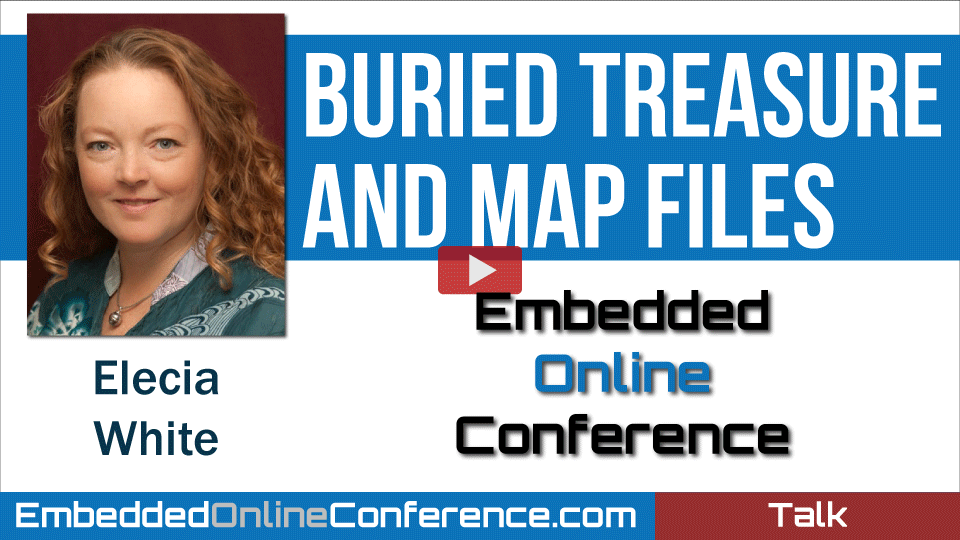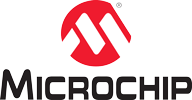Home > On-Demand Archives > Talks >
Buried Treasure and Map Files
Elecia White - Watch Now - EOC 2021 - Duration: 35:18

Often overlooked, the map file can provide a wealth of information to the intrepid developer. Map files can help:
- optimizing for RAM usage and/or code space
- updating firmware (with or without a bootloader)
- debugging difficult crash bugs
- statistical profiling
With so much information, how can you use it? Where do you look? How do you turn the wall of text and numbers into a true map of the code?
Elecia will demonstrate how to use map files. She will focus on an ARM Cortex-M but it will be relevant to other processors.
Useful presentation and Q&A.
I mainly use them to paste the usage summary at the bottom into Excel, to plot memory growth over time. I can then extrapolate and see visually if it?s going to have sufficient space by the end of the project. Occasionally it has shown it?s getting too tight, but after shuffling things around in memory the new slope and offset of the line shows that it?s back on track, with plenty of future growth potential. I store all mine as artefacts with every Jenkins build, so you don?t have to rebuild an old version just to get this information. I need to script this sometime, but it takes about 10 minutes every few weeks to keep Excel up to date with the last few builds I?ve done.
The comment from Michael (sorry if spelt incorrectly) about the bootloader was interesting. Were both linker command files set so they didn?t overlap in memory and the build would simply fail if it ran out of space?
Only 1 minute into your presentation and I realized that we are kindred spirits! :) I totally identified with what you said about the joy of eking out a few more processor cycles, efficiently writing a hardware driver, or reducing memory consumption! I'm glad to hear that there are still other people out there that enjoy this.
This was an excellent presentation!
Great job Elecia of making map files beautiful! Your map art has a "Lord of the Rings" feel to me so the only thing missing is in one corner your portrait dressed up as Galadriel Elf Queen of Memory Map Land. :-) A couple of comments: To extend the Analogy the Linker Definition file is the Cartographer. I have quoted you in the past for your definition of an Embedded System from your book "An embedded system is a computerized system that is purpose-built for its application." I would like to submit a possible test if someone is an experience Embedded System Engineer is "Have you used a map file to find and fix a defect". I highly recommend anyone who is an Embedded System Developer listens to the Embedded Podcast https://embedded.fm/ and help support by being a Patron with the side benefit of getting on the community Slack Channel.
It's an interesting idea to use the map-file for analyzing the firmware size. Most of the time I was experimenting with "bloaty" (https://github.com/google/bloaty). Although this tool is parsing the elf file and not the map-file. Maybe also interesting to look at.
Thanks for the great talk and some cool insights into map-files.
That's a very cool memory map! I love it. Just one thing that may sound like a nitpick, but might confuse people with map-making experience: Rivers never split. So when I saw the .cinit area, and the river of initialization, I immediately though that the .bss influenced .cinit, not the other way around. A better way to represent what you want would probably be making .cinit be surronded by 2 rivers, one going to the ocean, the other to the lake.
regardless, that map is a huge help, thank you for sharing it!
Your map of the map file was very clever. I might have to find a space on my wall for it. Very well done presentation on a formidable topic. I found map files inscrutable initially and struggled to make sense of them, but over the years the information they contained was invaluable in debugging.
Nice Job Elecia, That colorful map is a great way to highlight what a .map file is all about. Really makes the point.
How can I access "the map"? I reeeeally need to print and frame it. For work.
My website has the HD image (click on the map):
http://embedded.fm/blog/MapFiles
And when I asked a graphic designer friend where they should be printed, Society6 was the recommendation so I put it there (with a 1% markup, the minimum I could do). So if you want to print it elsewhere, go ahead. Maybe send me a pic of it in your lab/office/above your fireplace.
https://society6.com/embeddedfm
Hi Elecia, that was a great talk!
I still remember having to troubleshoot missing startup code (no zeroing, no initialized variables) in my final uni project. This taught me the answer to that eternal interview question of "what happens before main".
How often have you had to write or adapt your startup code in real-world projects?
Some... but less in the last few years. Now that most systems have a startup.s and weak bindings for the interrupt vectors, startup code is more canned... that said, one area I used it on recently involved reading constants (specially marked section) from the spi flash into fast RAM for graphic assets for boot time imagery.
Interesting, do you simply modify the startup.s and call your own function to add your code, or how do you add it to the startup?
That's an elegant solution, will keep it in my toolbox
Oh, that reminds me. I created a small hobby project on an 8 bit avr about 6-7 years ago, written in C++. My first, trivial hello world-type code loaded and worked fine. But very soon when adding a bit of code, everything would compile, load fine, but the micro just seemed completely dead after loading. With no debugger I tried to light an LED in line 1 of main, nothing. Having no better resort, I used objdump to get a disassembly of the code and in part of the pre-main startup code linked in by avrgcc I found that a trivial file would do some memory clearing and then jump to another piece of initialization code, but with my non-working code, it instead jumped miles outside of any available memory. It was in a function called something with "ctors", so on a hunch I tried moving the one global object I had into main instead, so that it got allocated on the stack, suddenly everything worked perfectly!
For address/symbol lookup you can also use nm and addr2line (at least in the gcc toolchain).
addr2line, very nice when you're running a debugger in an environment that doesn't have access to the sources. A quick one-liner immediately tells you where in the code you are.
I'm going to add JeanLabrosse's suggestion of elfread as that seems quite useful.
Definitely, I believe the name is readelf by the way.
Saw that Embedded.fm is on YouTube. Will you be doing video podcasts and interviews? Thought you could be very creative with them after seeing this presentation.
Probably not... Video is a really hard medium. It would require too much time so we'd have to make money from it but I'd rather share information freely and get paid to do engineering.
Any plans to produce the map as a print we could buy? :)
Sure! My website has the HD image (click on the map):
http://embedded.fm/blog/MapFiles
And when I asked a graphic designer friend where they should be printed, Society6 was the recommendation so I put it there (with a 1% markup, the minimum I could do). So if you want to print it elsewhere, go ahead. Maybe send me a pic of it in your lab/office/above your fireplace.
https://society6.com/embeddedfm
Thanks Elecia, and thanks again for the presentation. Loved the style and take on what could have been a real snooze fest! Hope to see more presentations in the future.
You should definitely make it into a board game. "Come on kids, let's play hard fault!"
It's available here as it seems: https://society6.com/embeddedfm
You can even change the currency. It would be cool if the ? price means prints are shipped from within Europe :)
Awesome, thanks Tarik
Hi Elecia! Great talk! Long-time-listener-first-time-caller. Gcc and other compilers have been around for a while now and I've wrestled with them (and linker scripts) myself. Why do you think these files are still so difficult to read? Do compiler vendors not realize that they could help developers a lot by making them more user-friendly?
Not enough people ask for them to better... It is one of those areas that isn't as spiffy as 2% faster compiles or better security for their licenses.
Very original. Loved "the map"!
Thanks!
Do you like to 'name sections' to allow you to determine where your section is located or do you simply always let the linker place memory? Naming sections is important if you use an MPU but not as critical for non-MPU systems.
Naming sections is also important if you have something that needs specific placement: bootloader, non-volatile storage, config information to pass between images. But if I don't have to, I'll let the linker do the work.


























That map is so cool I'm definitely going to print it and stick to my office waall!